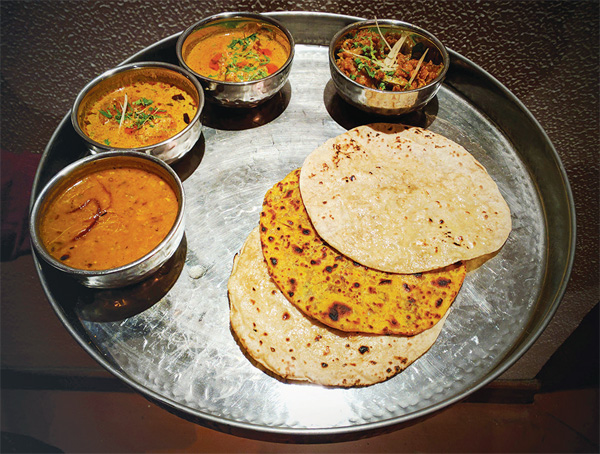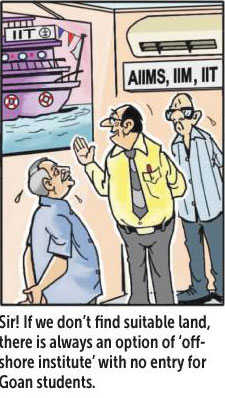22 Aug 2017 | 03:08am IST
Feeling deserted and loving it
Don Jevonn
Ever since I
made my maiden voyage across to
Rajasthan in 2015, I have been fascinated with the state’s food,
and wanted to discover a greater amount about the gastronomy of the state. It’s
diverse, no doubt, and clearly divided in opinion about the consumption of meat
and vegetables, and which is greater than the other. For some reason, in more
recent times in Goa, there’s been an upswing in the places that have been
focusing on Rajasthani food, and the most recent promotion is one that has been
undertaken by one of my preferred properties, Park Hyatt Goa Resort and Spa;
one that they have simply titled ‘Rajasthani
Bhojan’, which is in focus
at their ethnic-themed restaurant, ‘Masala’.
I began my evening of gastronomic exploration with a refreshing
drink (it was a warm evening, in keeping with the Rajasthani cuisine, the Gods
sorted that one for me) called
Kairi ka Jaljeera, a mango and cumin
infused drink that was absolutely delightful. Let’s just say that it was highly
reminiscent of liquidised
hajmola; and who doesn’t love
hajmola?
The first course was titled
prarambh, and it really did
serve as a warming of a long-drawn evening ahead. Several dishes made up the
round, from
‘Paneer ke Sule’, which was char grilled cottage cheese with
red chillies, to
‘Pyaaz Kachori’, a deep fried, onion-stuffed savoury
disc, hollowed out and filled with a series of embellishments,
‘Kamli Vada’,
a deep fried lentil dumpling that is meant to be eaten with chutney,
‘Udaipuri
Tangdi’, a chicken drumstick marinated with yoghurt and spices, and my
personal favourite of the course,
‘Maas ke Sule’, char-grilled lamb that
had been marinated with yoghurt and chillies. The little chunks of meat were
flavourful beyond belief and possessed a smokiness that I yearn for in most
meals, and do not seem to find.
The main course, labelled
mukia bhoj, was then brought
forth in the form of a
thali with many assorted offerings. The
thali was
laden with
vatis, or little metal, ramekin-like dishes, each containing
portions of many varied forms of Rajasthani cuisine. This included the likes of
the
‘Mewad Subz’, which was a combination of mixed seasonal vegetables,
tossed with fresh onion and tomato,
‘Rajasthani Kadi’, a spiced yoghurt
curry with fried lentil dumplings,
‘Ker Sangri’, a classic dish, made
combining dry leafy vegetables tempered with pickled spices, a shrub berry
called
ker, and
sangri, the bean of a flowering tree called
khejari,
and
‘Gatte ki Subzi’, a steamed and fried dumpling soaked in a yoghurt-based
curry.
No Rajasthani meal can ever be complete without the evergreen
dish that is associated with the state – ‘
Dal Bhati Churma’, a
traditional Rajasthani marriage of sweet and savoury. Conventionally, the
bhati,
a round, almost hard bread, would be baked over firewood or over
kandas (cow
dung cakes), before being soaked in ghee. These are then served with the
savoury
dal and sweet
churma. Together, as simple as they sound,
these three make up a culinary holy trinity of sorts, when it comes to
Rajasthani food. It was on our
thali too, and it certainly didn’t
disappoint, with all the flavours being on point.
And speaking of
classics from the region, how could one fail to make a mention of the
‘Laas
Maas’, the state’s flagship mutton dish, famous for its zesty incorporation
of a massive amount of red Mathania chillies? It has been said that the
excessive use of chilli stemmed from the fact that the meat first used, boar or
deer, was gamey, and as such, the chilli would help conceal the odour. Here,
however, the dish is more contemporary, with tender bits of lamb being used,
and to be fair, the spice has been toned down…a lot.
Counterbalancing this
dish was the
‘Safed Murg’, an extremely mild Rajasthani delicacy made of
chicken that highlighted all the flavours of yoghurt and cream, belying the
spices that lay underneath. It is the perfect companion to the ‘
Laal Maas’; one
fires you up, while the other settles you down.
The carbohydrate
component on this massive platter comprised the classic
‘Phulka’ –
supremely healthy and made of whole wheat, cooked on a griddle, an interesting
flatbread called a
‘Masala
Tikadia’, which is also whole wheat,
but rather reminiscent of the Gujarati thepla, and last on this list, the
‘Gatte
ka Pulao’, which was a lot like a cross between a biryani and a pulao, but
interspersed with the conventional spiced dumplings representing the gatte side
of things.
The evening ended
with a healthy dose of the sweet stuff in the form of a rich almond pudding or
‘Badam
Halwa’. Utterly decadent, it seemed to ooze ghee. Did I say healthy? Never
mind! What’s life without an occasional walk on the waistline’s wild side?
This
little journey won’t run for too long; only until August 27, 2017, in fact.
There’s no time like the present to get yourself there; just a friendly piece
of advice: skip your previous meal.

